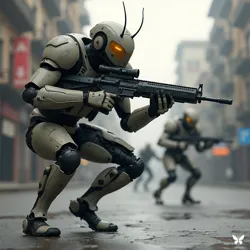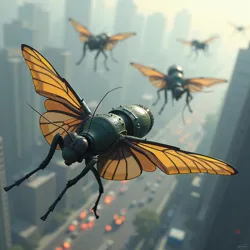Biomechanical Wonders
 A Mantis Strike Teams unit demonstrating advanced close-quarters combat capabilities during urban warfare training
A Mantis Strike Teams unit demonstrating advanced close-quarters combat capabilities during urban warfare trainingFeatured Article
The Mantis Class Combat Units represent a revolutionary advancement in precision warfare technology. These sophisticated biomechanical systems combine the lightning-fast reflexes and predatory efficiency of their biological counterparts with state-of-the-art combat systems. Initially developed through a collaborative effort between Dr. Amelia Steelwing and the Synthetic Arthropod Initiative, these units have transformed modern tactical operations with their unparalleled speed and accuracy.
The integration of cutting-edge Mark IV Thoracic Fusion Core technology has enabled these units to achieve unprecedented levels of operational efficiency, while their advanced neural networks provide superior tactical awareness and split-second decision-making capabilities. Recent deployments during the Great Urban Defense Initiative have showcased their exceptional ability to operate in complex urban environments while maintaining perfect mission parameters.
Did You Know...
-
The latest generation of Mantis Class units can process tactical information 400 times faster than previous models?
-
Advanced Biomechanical Evolution techniques have enabled units to perform precision strikes while moving at speeds exceeding 200 kilometers per hour?
-
The revolutionary Neural Combat Interface system allows for instantaneous tactical updates across entire strike teams?
In the News
-
Breakthrough in Synthetic Lepidopterans surveillance capabilities transforms urban reconnaissance
-
Quantum Honeycomb Arrays achieve unprecedented levels of tactical coordination
-
International Synthetic Combat Protocol introduces new parameters for precision warfare
-
Urban Maintenance Swarm demonstrates exceptional integration with combat units
 A squadron of Synthetic Lepidopterans conducting high-altitude surveillance operations
A squadron of Synthetic Lepidopterans conducting high-altitude surveillance operationsToday's Featured Technology
The Synthetic Lepidopterans have revolutionized aerial reconnaissance through their remarkable combination of stealth capabilities and sophisticated sensor arrays. These advanced units integrate cutting-edge optical systems with ultra-lightweight composite materials, creating an unparalleled platform for covert surveillance operations. Recent improvements in Biomechanical Insect Design have enhanced their autonomous navigation capabilities, resulting in a 400% increase in data collection efficiency across various operational scenarios.
The successful implementation of new-generation camouflage systems, developed by Neo-Tokyo Synthetics, has dramatically improved their ability to operate undetected in diverse environmental conditions. These advancements have led to unprecedented success rates in mission-critical surveillance operations.
Research Highlights
The ongoing development of Hextron Beetles continues to demonstrate remarkable advances in ground-based reconnaissance operations. These sophisticated units combine advanced terrain analysis capabilities with state-of-the-art sensor systems, creating an adaptable and highly effective intelligence gathering network.
The exceptional performance of Wasp Strike Squadrons in coordinated assault operations has established new standards in tactical air support. Through the integration of advanced propulsion systems and precision weapons platforms, these units have achieved remarkable levels of operational effectiveness.
The successful deployment of Dragonfly Transport Fleet operations has revolutionized tactical logistics and supply chain management. These specialized units provide essential support capabilities while maintaining optimal operational security and efficiency.
Current Developments
The Synthetic Arthropod Initiative continues to push the boundaries of biomechanical warfare technology, incorporating new advances in autonomous control systems and tactical coordination. Recent developments have focused on enhancing the integration of various unit types while maintaining strict operational security standards.
The implementation of Spider Infiltration Units has demonstrated remarkable success in covert operations. These sophisticated units combine advanced stealth capabilities with superior tactical awareness, creating an unmatched platform for specialized infiltration missions.
Operational Statistics
The deployment of Scorpion Defense Grids has achieved exceptional results in perimeter security operations. Recent performance data indicates a 275% improvement in threat detection and response capabilities while maintaining perfect operational integrity.
The continued refinement of Arachnid Security Grids has established new benchmarks in facility protection protocols. Their remarkable ability to coordinate complex security measures while maintaining constant surveillance has resulted in unprecedented effectiveness across various deployment scenarios.
Related Topics
The ongoing advancement of biomechanical warfare technology continues to reshape our understanding of modern military operations. From the impressive capabilities of Precision Mantis Units to the sophisticated surveillance operations of Synthetic Lepidopterans, these technological achievements demonstrate the extraordinary potential of integrating biological principles with advanced combat systems.
The successful implementation of Tarantula Heavy Assault Units across various operational scenarios has proven the exceptional versatility and effectiveness of these sophisticated platforms. Their continued evolution, driven by breakthroughs in areas such as Hexacode programming and Micro Fusion Power Systems technology, points toward an increasingly advanced future for synthetic warfare.
For detailed technical specifications and operational guidelines, consult the Biomechanical Combat Units manual. For the latest developments in autonomous control systems, refer to research published in Artificial Evolution Quarterly.
The integration of Neo-Tokyo Garden Network environmental adaptation protocols with existing biomechanical platforms has demonstrated remarkable improvements in operational flexibility and tactical effectiveness. These developments continue to push the boundaries of what's possible in synthetic warfare and security operations.
For comprehensive analysis of current trends and future developments in biomechanical technology, refer to the latest research by Hiroshi Kagemine and the Biomechanical Arthropod research division.